Kefalonia Towns and Villages
Breathtaking island
Kefalonia (or Kefalllinia) is the largest and most mountainous of the Ionian Islands. It is situated opposite the entrance of the Gulf of Patras, north of Zakynthos, south of Lefkada and west of Thrace. The island’s capital is Argostoli. Kefalonia has two ports that connect the island with the rest of Greece. The first one is the port of Sami, where ships to Ithaca, Patras, and Italy leave from. The second is the port of Poros, on the southeast of the island, where ships to Kyllini leave from. Kefalonia is full of vegetation and it’s famous for its beaches, as well as its unique geological phenomenons, like the Lake Cavern of Melissani and the sinks.
Kefalonia is the largest island of the Ionian Sea with the breathtaking nature and the beautiful waters look like a miniature of Greece. Its territory is mountainous while the Ainos Mountains National Park dominates a large part of it. The economy over the past years was based on livestock farming and agriculture, but in recent years the main economic factor is tourism. Thousands of tourists from Greece and abroad visit the island, especially during the summer.
Throughout the coastline of the Kefalonia, you will find dreamy beaches, some of which are among the most beautiful in the Mediterranean. Among them is the photographed Myrtos, one of the ten most beautiful beaches in the world with turquoise waters and golden sand.
A real paradise for nature lovers, Kefalonia offers unforgettable trips to trails running through traditional settlements and rare geological phenomena (Katavothres, Karavomilos, Drogarati, Kounopetra). Pilgrimage for hikers and mountaineers, the Ainos National Park with numerous marked paths and enchanting trails hosts among other things a protected, endemic and other rare species of flora and fauna.
Travel to Kefalonia island and explore the countless beauties of the great island endowed with nature and history.
Kefalonia at a glance
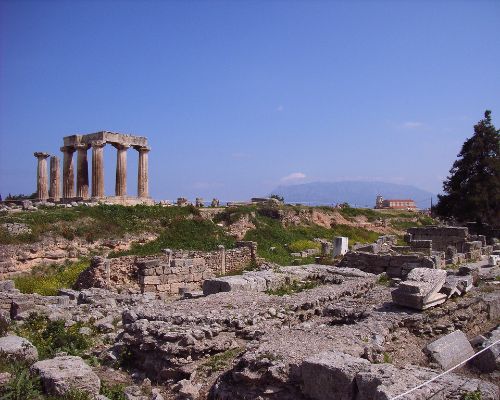
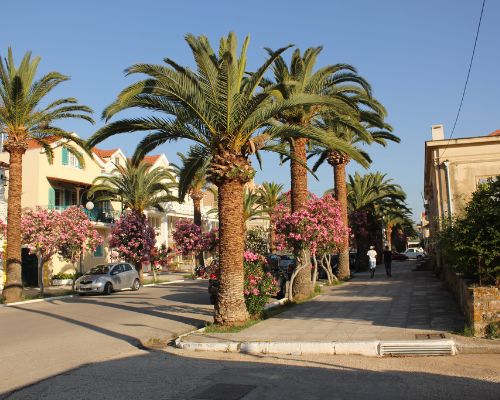
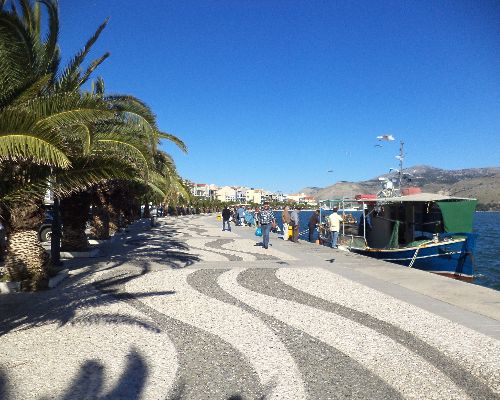
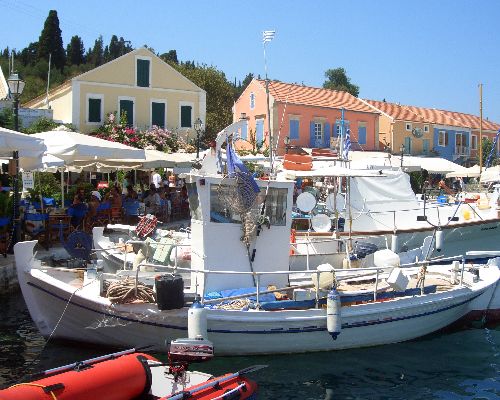
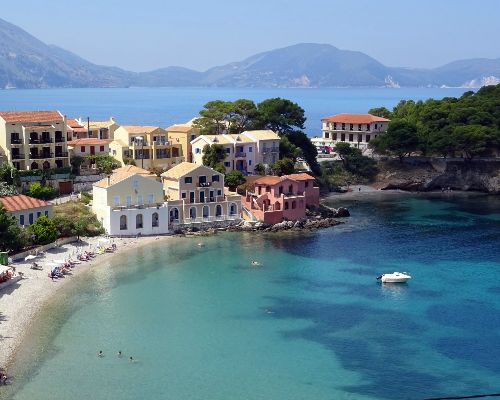
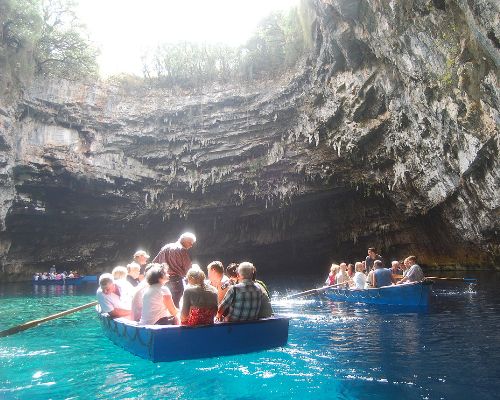
Agia Irini is a very picturesque evergreen village. It has 366 inhabitants and it belongs to the Municipality of Elios – Pronnoi (southeast Kefalonia).
The old name of the village was “Arakli” which probably derives from “Iraklio”, the biggest city in Crete. Thus, it is very probable that its first inhabitants were Cretans from Iraklio.
Many locals have been distinguished in business abroad, where they moved after the 1953 earthquake. Nowadays, most of the young people in Agia Irini work in the tourism sector (Poros, Skala, Katelios) with great success due to their capacity to adapt to new conditions.
The extended valley, the rivers that flow during the winter under the sycamore trees, the three fountains, the tank lake, and the flowery surroundings, are the pride of the village. Great help towards the development of the village is offered by the cultural association “Arakli”.
During the summer, the village gets a cosmopolitan aura as it becomes crowded, and the wonderful Ionian sea reveals its marvelous beaches at a close distance.
Agia Efimia is a beautiful small country town with a picturesque harbor which attracts a lot of yachts. In Agia Efimia – called “Agia Thimia” by the locals – are the headquarters of the Municipality of Pilaros. Agia Efimia means “Saint Honor”, a name derived from the small white church which stands in the port. Around the gulf of Agia Efimia, there are two mountains, Agia Dinati, and Kalonoros and 24 villages. The locals are mostly farmers and seamen.
Tourism is well organized in Agia Efimia, and the visitors may get all the services needed for a fine holiday. The town is located at a 9 km distance away from the harbor of Sami and it has got magnificent landscape and beautiful beaches. Along the road to Sami, there are several small beaches, suitable for one or two groups each. Myrtos, the most celebrated beach of Kefalonia, is just a few kilometers away.
How big is Kefalonia
It is 50km 31 miles long and the largest (735km – 284sq miles) of the Ionian Islands.
The landscape is varied; smiling terraces by the sea contrast with the more arid mountain slopes which nonetheless support clumps of cypresses among the olives.
Mount Ainos (Enos), the highest point (alt 1 628m – 5 941ft), is covered by a particular kind of spruce peculiar to the island.
Local specialties include the delicious Robola wine, dishes composed of meat and rice and thyme-flavored honey.
The Kefalonians are reputed to be a spirited people whose patriotism was praised by Byron.
The island has not only produced soldiers, sailors, and enterprising emigrants but has also fostered an aristocratic and cultivated society which produced scholars and politicians such as Metaxas (1871-1941) who rejected the Italian ultimatum on 28 October 1940.
History Of Kefalonia
The name of the traveler was Kefalos.
But Kefalonia was named after Kefalas, a tribe from western Greece.
Mythical Age
According to mythology, the first settler of the island was Tafios, son of Neptune, the god of seas. The island was called Tafos and its inhabitants Tafioi or Tilevoes. Ptereleos, son of Tafios, conquered the islands around Cephalonia and became powerful. In Lixouri, there is an area called Tafios, and that gives a historical dimension to the myth. Later arrived at the island Kefalos and Elios. Kefalos had four sons, Palea, Kranio, Samio, and Proniso, whose names took the four towns-states of the island. In Iliad we find for the first time the name “Kefalines”, a name given to the citizens of Ulysses, that is the citizens of Cephalonia, Ithaka, Zante, Lefkas, and Akarnania. We find the name of Cephalonia again in Herodotus in the 5th-century BC, when the historian mentions the citizens of Pali.
Prehistorical Age
The history of Cephalonia starts at the Middle Paleolithic Age. According to findings of bones of mammals, in 40000 BC, the island was still united with the mainland. Then populations of nomads moved to the western part in order to find food. There are found many instruments of the Stone Age hand axes, knives), mainly in caves at the northern and south-eastern part of the island.
Ancient and Roman Age
In antiquity Kefalonia had four towns-states, Pali, Krani, Sami, Pronnoi, therefore it was called Tetrapolis. These towns were independent, with a separate administrative and military organization. The coins and the ruins of the fortresses sue to the existence of four different authorities on the island. During the historic period, the regime of the towns was democratic, which is proved from several findings, like the absence of the representation of a lord, with the exception of Kefalos, on the coins. Despite the political independence of the towns, the civilization on the island was evolved uniformly. It seems like there was a particular blossom during the Mycenaean period since there are plenty of findings, especially tombs, from that period. The towns formed several alliances with the sovereign forces of Greece. Is renowned the alliance with the Corinthians (479-435 BC), the Athenians (431-404 BC), the Spartans after the Peloponnese war and then again with the Athenians, who dominate for several years. During the Hellenistic period (226 BC), there’s naval cooperation with the Aitolic Confederation. Romans conquered the island at the beginning of the 2nd-century BC, after Corfu and Zante(Zakynthos). From the period is renowned the besiege of Sami, that lasted four months. The town resisted strongly, but when it was conquered, it was destroyed and the citizens were sold as slaves.
Byzantine Age
There isn’t much information about Kefalonia until the 8th-century AD. From that period is renowned that the island was the center of the administrative region that was consisted of the Ionian islands and Bari, Italy. The strategical position of the island was important for the defense of the empire, especially against the attacks of the Arabs. Piracy was very popular and the Arabs, sailing from the coasts of Africa, terrified and destroyed many regions of the Mediterranean.
Frankish Domination
In 1185, Kefalonia passes under the commands of the Franks. Until 1479, lords of Kefalonia are the Norman pirate Mergaritonis, Matteo Orsini, his son Ricardo Orsini, Ricardo’s son Giovanni I, Leonardo Tocco, his son Carlo I, and Carlo’s wife Francesca. In that period is quite strange the governing of a region from a woman, especially if we take into consideration that there are several documents for a general gynecocracy.
Turkish Domination
The presence of the Turks on the island was brief, it lasted only 17 years. During the first period (1479-1481) the island was taken by Achmet Pasha of Avlona. The consequences were catastrophic: the castle was burnt and many citizens were taken to Constantinopolis. The Venetians took the island in 1481, but in 1485 they gave it back to Sultan Vagiazit II. Then was established at the castle a small Turkish force, which was capable of terrifying the local population. After intensive assertions, the locals started leaving the island, and as a consequence, there was a dramatic reduction of the population until 1500, when the Venetians took back the island.
Venetian Domination (1500-1797)
In 1500, after convergence with the Turks, Venetians took over the administration of Cephalonia and lots of things started to change. Supreme Lord of the island was the Venetian Thrift, still, the local population participated in the administration. There was the Community Council, a numerous jury consisted of local nobles, who were listed on the Libro d’Oro (book of nobles). That gave a gloss of democracy in administration, even though all important decisions were taken by Venetians. In any case, the changes to a better life were visible. Inhabitants started to increase and assumed the cultivations. There was also an afflux of the population from other places, which accompanied historical events like the conquest of Cyprus in 1570 and Crete in 1669 by the Turks. Then arrived at the island many intellectuals. Cephalonia became a node of strategical importance for the Venetian fleet, the ports blossomed, the St George’s castle was rebuilt and became capital of the island, and a few years later was built the castle of Assos. Cephalonians had access to the West, and as a result, they started traveling often for commerce and studies. This material and spiritual exchange had, as a result, the foundation of important schools and universities, like the School of Vicenzo Damodo at Chavriata. Along with the education started the organization of the health system and of the Church as well. Of course, all that had to do with the peerage and not the folk.
Russian Domination
The pleasure for the arrival of the French didn’t last long. The Russians, with methodic efforts, increased their influence, and as a result, there was a revulsion of the driftage of the population. There were arousals in Livatho and Lixouri and finally the French withdrew. In October 29th, 1798, the Russian fleet arrived at Argostoli and the Russian flag substituted the french one. This period was also brief since the efforts for the independence of the Ionian islands had already started.
State of the Ionian Islands (1800-1807)
On May 21st, 1800, was signed in Constantinopolis a convergence that recognized the independence of the Ionian islands with the name “State of the Seven United Islands”, with the suzerainty of Turkey. It’s the first independent Greek state of modern history, with its own constitution and legislation. This institutional form though didn’t last as there were autonomic arousals, especially in Lixouri, until the abolition of the State in 1807.
Second French Domination
On September 1st, 1807, the French regained the island, under the commands of general Ceaser Berthier, who was replaced by the colonel Lorenzo Pierri. The anti-french movement on the island was enforced by the scopes of the British, and as a result, this administration didn’t prosper.
British Domination
In October 1809, the French hand over the island to the British general Oswald. During the first years of British Domination, luminary personality is the Swiss military Charles Philip De Bosse, who established very important operas, like the streets of the island and the Devosseto bridge. Another celebrated personality was Charles Jacob Napier, who also constructed very important public buildings, like the famous Marcato of Lixouri. The successive conquers and the seigniorial regime led to serious armed arousals, with the aim to subvert the diversification of classes and the union with Greece. The most important took place in 1848 and 1849. These convulsions had terrible consequences for the population, like sequestrations of belongings, exile, and executions.
Union with Greece
Finally, in October 1863, Cephalonia and the rest of the Ionian islands are united with Greece. Then, all political convulsions stop, and the radical tradition of the island is expressed by Panagiotis Panas, Roccos Hoidas and Marinos Antipas, who were pioneers of socialism in Greece. Until nowadays, Cephalonia keeps pace with the political process of Greece, contributing drastically at the enforcement of democracy, political freedom, and social prosperity.
Invasions and Invaders
Kefalonia did not play a major role in antiquity although several Mycenaean tombs have been discovered. During the Middle Ages, the island first belonged to the Norman kings of Sicily, one of whom, Robert Guiscard, died on Kefalonia in 1085. Then it became the County of Kefalonia, one of the great fiefs of the Frankish principality of the Morea, and included Ithaca and Zakynthos. For three hundred years it was ruled by Italian overlords: the Orsini from 1155 to 1356 and the Tocchi until 1478.
The Turks held the island for only twenty years; by 1500 the Venetians, assisted by the Spanish troops of Gonzales of Cordoba, the Great Captain, had recaptured the island and they held it until 1797.
After 1808 Kefalonia was occupied by the British, who promoted many improvements under the Residency of Sir Charles Nappier.
In 1823 Byron spent four months in a rented house in Metaxata near Argostoli before sailing to Messolonghi.
The island was finally returned to Greek control in 1864.
When Marshal Badoglio signed an armistice with the Allies in 1943, 9 000 Italians belonging to the “Acqui” Alpine division held out for 9 days against the German air and land attack.
When they finally surrendered, the survivors — 341 officers and 4 750 soldiers — were shot en masse on Hitler’s orders; only 34 escaped.
In 1953 an earthquake caused severe damage throughout the island.
Sami. Pop 935. The port of Sami nestles in a gently curving bay (beaches) where the fleet of the Holy League assembled on the eve of the battle of Lepanto.
There is a fine view of the narrow entrance to the bay and of the stark coast of Ithaca.
Melissani Cave. 3km – 2 miles northwest; take the road to Agia Efimia, turn left into the track which leads to the cave.
The underground lake which receives its water via subterranean passages from the swallow holes (katavothres) near Argostoli, is explored by boat.
The roof has fallen in places but the intensity and variety of the colors of the water, the contrast of light and shadow and the resonance and echo produce a fantastic effect.
Drongarati Cave. 2km – 1 1/4 miles southwest; take the road to Argostoli and after 2km – 1 1/4 miles turn right into a track.
A flight of steps leads down into this cave, which is easy to explore.
Argostoli
The road from Sami crosses the Agrapidies Pass which gives a magnificent view of the site of Argostoli, stretching away below along a promontory towards the Lixouri peninsula.
The main approach to Argostoli is over a bridge, 650m – 711yds long, which crosses the Koirtavos Lagoon and was built between 1810 and 1814 by Posset, a Swiss working for the British.
After the earthquake in 1953, the capital of the island had to be rebuilt and has unfortunately lost its Greco-Venetian atmosphere.
It can, however, be recaptured by visiting the Korgialenios Museum.
A remarkable collection of old costumes, documents relating to Argostoli in the past, reconstructions of the interiors of aristocrats’ houses and craftsmen’s workshops.
Swallow-holes (katavothres).
Near the end of the promontory, level with a restaurant, the sea water flows into a fissure and disappears underground before reappearing on the other side of the island in the Melissani cave on the principle of communicating vessels.
The hydraulic power thus created was used to turn the mills of which one example with its paddle wheel can be seen.
View of the sea and the Lixouri peninsula.
Among the beautiful concretions are some enormous stalagmites.
Climate in Kefalonia
“Indigo, the deep blue contains an abundance of sapphires shining their light through the density, awakening and stirring our consciousness. In the daylight the sea will change, but for now it remains mysterious, obtainable through our imagination.” ― Jennifer Lynch
How to get to Kefalonia
The island of Kefalonia is the largest of the Ionian. It is located in the middle of the Ionian Sea, within walking distance of mainland Greece. You can go to the island, either by boat or by plane.
By ship
Transport Starting from Athens, you can take a bus or bus to go to Patras (2.5 hours) or Killini (3.5 hours). Then from both of these ports, you can take a ferry boat to reach the island of Kefalonia. Itineraries are daily and especially frequent during the summer months. From the port of Patras, you will reach the harbor of Sami, after 3.5 hours and from the port of Killini, you will reach the harbor of Poros, after about 1.5 hours. Lastly, from Astakos to Aitoloakarnania there is a ferry service to Sami, Kefalonia, and the journey takes 2.5 hours. For other ferry connections, you can go from Argostoli to Lixouri in 20 minutes, as well as visit Ithaca, Zakynthos, and Lefkada. Finally, during the summer there is a weekly route connecting Kefalonia to Brindisi of Italy, and more rarely to Venice, Ancona, and Bari.
By air
Kefalonia Airport is 9 kilometers distance from the island’s capital, Argostoli. Transfer to and from the airport is by taxi, car or buses that are being run for this purpose. The Athens-Kefalonia air link is available all year round, every day at least once, with the exception of the summer when flights are more frequent due to demand. The flight takes about 45 minutes without stopping. During the high tourist season, extra flights from other cities in Greece as well as from abroad via charter flights are scheduled.
If you are looking for airline tickets and flights to Kefalonia enter the dates of arrival and departure in the left box, and the online reservation program will show you suggestions and prices for your flight where you can make your reservation directly and securely.
Get around
Kefalonia has an extensive network of good road and regularly scheduled buses serving:
a. travel from the capital of each district
b. travel between the towns and villages in each district.
Bus
The central bus station of KTEL is in Argostoli and you can find detailed information on all itineraries there. There are buses that cover many areas on the island and tickets are very cheap. From Argostoli, there are 4 daily sailings for Sami and from Argostoli to Fiskardo.
Taxi
The central taxi stop is located in Argostoli, in Valianos square, but you can also search for taxis either on the main streets in the most popular places or via the radio taxi service. There are default rates for most popular destinations, and taximeters are used for some other routes.
Car
If you keep in mind that Kefalonia is the largest island in the Ionian sea you should definitely understand why the car is the ideal mean of transportation! The island has many beauties that you can definitely not explore by bus or taxi and the car will make it much easier. You can simply, quickly and cheaply rent a car using the online car rental service.
Distances
Argostoli – Fiskardo: 50
Argostoli – Poros: 43
Argostoli – Skala: 40
Argostoli – Sami: 24
Argostoli – Agia Efimia: 36
Argostoli – Lixouri: 8
Useful Telephones for Kefalonia
Kefalonia Police : ( + 30 671) 22200
Kefalonia Argostoli Port Authorities:( + 30 671) 22224
Kefalonia Poros Port Authorities:( + 30 674) 72460
Kefalonia Sami Port Authorities:( + 30 674) 22031
Killini Port Authorities:( + 30 623) 92211
Kefalonia Airport: ( + 30 671) 41511
Olympic Airways: ( + 30 671) 28808
Hospital ( + 30 671) 22434
Health
Kefalonia Gastronomy - local products
In the taverns, try the typical sausage pie, goat’s sauce, potatoes, spinach and herbs with rice and rabbit sauce (a rabbit fried and cooked with garlic and lemon). The Kephalonians also love the hot sardines (with potatoes) and boiled zucchini. And, of course, you will not leave the island without taking some of their traditional flavors with you: mandolos (typical keflonated roasted almonds with sugar coating), Robola wine or thyme honey.
Night Life
Restaurants can be found all over the island.
Night clubs and discos in Viniares, Agio Theodoro and Fanari.
Kefalonia Tours
From Sami, you can pass to Piagetos Ithaca in half an hour. You should take the coastal walk to the charming Vathy, Kioni and Frikes. There you will see the idyllic bay of Schinos, the pebbled Gidakis or Ai-Giannis beaches with a background of Kefalonia. And yet, discover the old churches of the ruined Paleochora, the small archaeological collection on Stavros, the church of Panagia and Anogi. For panoramic views, set up at the Monastery of Katharon and at the old monastery of Panagia in Pernarakia. The ferry from Fiskardo arrives at Lefkada’s Basilica in about an hour, so you can continue from there to the coastal fishing village of Sivota and the city of Lefkada.
Beautiful walk in the villages of Sfakioti, Karya and Egluvi, through ravines, slopes with cypresses and the path with the background of the sea from Ai-Nikitas to the beaches Egremni and Porto Katsiki. During the summer season the ship departing from Pessada reaches an hour and a quarter in Agios Nikolaos Volimes, in the north of Zakynthos. Nearby Astos Stone Park and the panoramic view of Navagio Beach are within walking distance. A nice carriage ride on the wild west coast to Keri. From Keri, via Laganas (the famous Caretta-Caretta sea turtle nesting turtle), you can continue for a walk in the city of Zakynthos.
Lixouri
Another popular destination is the beautiful Lixouri, the second largest city in Kefalonia, known for its carnival. It is also known for the Library with its huge collection of books. It has excellent tourist facilities and some of the best taverns on the island, while Xi beach is well known for the clay color of sand due to clay, which is essentially a natural spa, but also the beautiful beaches of Petani, Platia Ammos, Lepida, Atheras and others.
Sami
To the north and to the east coast of the island is Sami. It is built in the depth of a bay and combines the greenery of nature with the blue of the sea as the trees reach almost ashore. The film “Captain Corelli’s Mandolino” was filmed in the city and in the wider region. Here you will find many shops, rooms to let, restaurants and cafes. You can enjoy the sea on the main beach (Karavomylos) or Antisamos. Do not miss to visit the beautiful Melissani Cave. The further north you to the north you will see the village of Divarata, which is the nearest settlement on the well-known beach of Myrtos, the most popular on the island and one of the most beautiful, not only in Greece but also in the world.
Skala
At the southernmost end of the island, you will see the seaside settlement of Skala with its vast and busy beach with the water sports infrastructure. There you will find a beach bar, umbrellas and sun loungers. Other destinations on the island of Kefalonia are Poros, Svoronata, picturesque Fiskardo, home of poet Nikos Kavvadias and others.
Fiskardo
Traditional village on the northern edge of the island and favorite destination for cruisers. Experience with the seasonal aroma, stroll along the seaside and its alleys between colorful two-story mansions. There are also scenic routes to get here either from Argostoli or Agia Efimia (from narrow streets with panoramic sea views). It is connected by ferry to Lefkada (in Vassiliki) and Ithaca (to Frikes).
Assos Castle
A brilliant example of the Venetian fortification, built on the Assos peninsula, is linked to the land by a narrow strip of land. You can hear the hooves of the horses as you climb the uphill road on an autumn day, with the view of the Ionian sea on one side and Assos on the other.
Kipouria Monastery
Built-in 1759 on a cliff overlooking the sea, on the west coast of the peninsula of Paliki (15 km from Lixouri), it offers the most exciting sunset on the island, with the sun sinking in the Ionian Sea.
Visit: the well-known Katavothres 2 km away from Argostoli, the Caves of Melissani and Drogarati near the settlement of Sami, the beautiful beach of Myrtos, the Archaeological and the Historical Folklore Museum of Argostoli, the Venetian Castle of Agios Georgios in the village Peratata and others.
Monastery of Agios Andreas of Malapidia, Peratata
Historic female monastery to the south of the castle of St. George. It has an ecclesiastical museum with remarkable post-Byzantine icons, wood carvings and religious relics from all over the island.
Monastery of Agios Gerasimos
A Great site for the travelers as it houses the saint’s relic.
Monastery of Atros
The most ancient monastery on Kefalonia island (8th century BC), where the holy Klimis lived. Its medieval tower is very well preserved.
Saint Euphemia
A picturesque tourist hut opposite Ithaca, with cafes and taverns.
Activities
- In the summer, many cultural clubs make festivals and traditional dances
- There are many hiking trails, especially on Mount Ainos
- Water sports
- Shopping in he shopping streets of Argostoli town
- Horseback Riding
Entertainment
Watersports
Aquatic World-Diving Center
Explore with us Odysseus crystal waters, and discover the marine life with your hands as well as with your eyes. Let the diving professionals at AQUATIC WORLD make your vacation a memorable experience.

